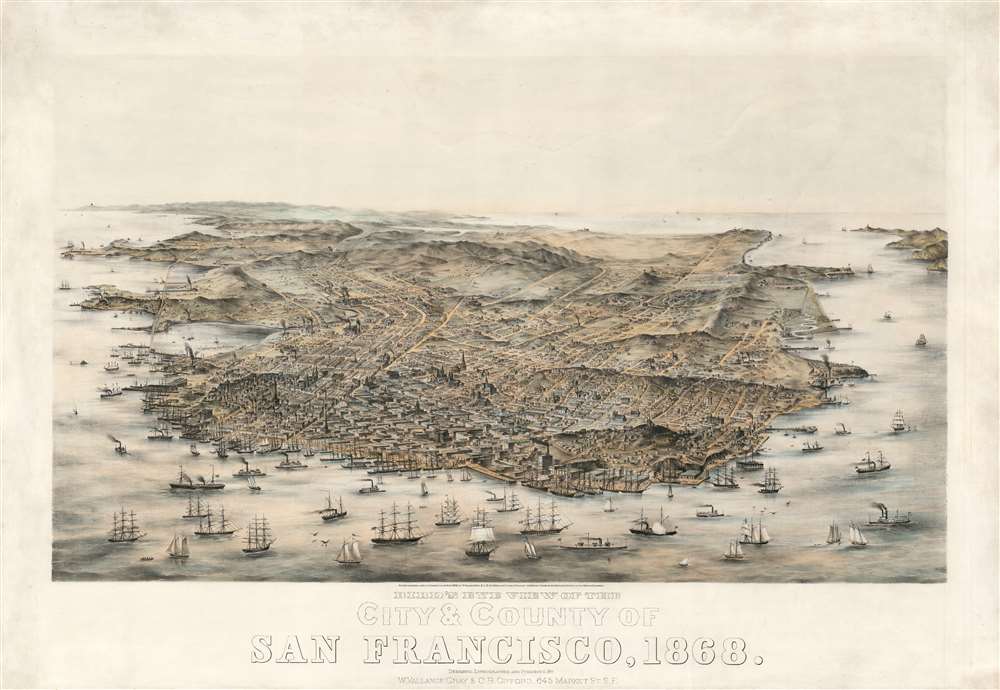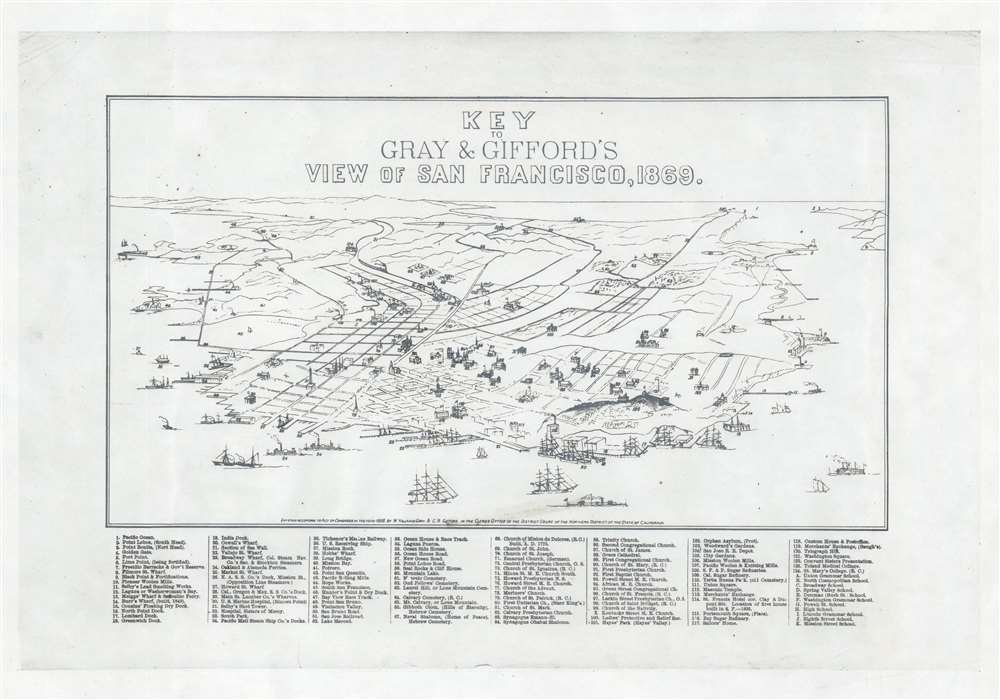This item has been sold, but you can get on the Waitlist to be notified if another example becomes available, or purchase a digital scan.
1868 Gifford and Gray Bird's-Eye View Map of San Francisco, California (First State!)
SanFrancisco-gifford-1868
Title
1868 (dated) 19.5 x 27.5 in (49.53 x 69.85 cm)
Description
A Bustling Port
San Francisco, which then had a population of roughly 170,000, appears as a bustling port city, its harbor teeming with ships of all kinds, including paddlewheels and steamers. Downtown San Francisco was then, as it is now, dominated by the diagonal cross of Market Street. Individual buildings throughout are easy to identify, underscoring the viewmaker's mastery of detail. Development does not extend significantly beyond Van Ness. The Presidio Military Reservation beyond to Golden Gate Park and the Pacific Coast, remain empty and barren. There is no evidence of the rail yards then being built at 3rd and Townsend, suggesting that updates to this view over previous states were limited to the title.Chromolithography
Chromolithography is a color lithographic technique developed in the mid-19th century. The process involved using multiple lithographic stones, one for each color, to yield a rich composite effect. Oftentimes, the process would start with a black basecoat upon which subsequent colors were layered. Some chromolithographs used 30 or more separate lithographic stones to achieve the desired effect. Chromolithograph color could also be effectively blended for even more dramatic results. The process became extremely popular in the late 19th and early 20th centuries, when it emerged as the dominate method of color printing. The vivid color chromolithography produced made it exceptionally effective for advertising and propaganda imagery, but it could also achieve great subtlety of detail, as is evident here.Provenance
This view comes from the private collection of a former vice president of the San Francisco branch of the firm of Balfour, Guthrie and Co., from whom he received it. According to him, the view hung 'for years' in the lobby of the Balfour Building offices of the firm. It is very possible that it hung there from the 1868 inception the import / export firm, which coincided with the year the view was printed.Publication History and Census
This rare view is based upon a painting by Charles B. Gifford, and was copyrighted and published in 1868. A second state was printed the same year, and there are three further recorded states of the view from 1869, 1872, and 1873. (5 states are catalogued by Reps.) There are only 7 examples, in various editions, held in institutional collections. The view seldom appears on the market in any state.CartographerS
Charles Braddock Gifford (1829 - November 17, 1888) was an American draughtsman, landscape artist, lithographer, and painter of city views based in and around San Francisco in the late 19th century. Gifford was born in New Bedford, Massachusetts. He worked in Massachusetts as a carpenter until about 1855, around which time he headed west to seek his fortune. By 1860, Gifford was established as a lithographer and landscape artist in San Francisco. His wife, Josephina, was from Nicaragua. His earliest views include the Mission Dolores, Vallejo and Santa Clara. Most of his earliest work was published by Louis Nagel, but later work was taken over by Bancroft. He began producing views in 1860 and continued to issue new views with various publishers until about 1877. He is best known for his highly ambitious 1862 view of the city on five large panels measuring some 9 feet across published with A. Rosenfeld. He issued approximately 15 views in total, most of which were of San Francisco area cities, but he also traveled to Washington state and issued several views there. Gifford died in San Mateo in 1888. More by this mapmaker...
William Vallance Gray (September 5, 1839 - October 15, 1891) was a Scottish-American artist, engraver, and lithographer active in San Francisco during the second half of the 19th century. Gray was born in Glasgow, Scotland. He emigrated to the United States sometime around 1860, settling in San Francisco. Gray was naturalized as a U.S. Citizen on October 16, 1868. By 1868 he had partnered in the lithography form of Charles B. Gifford. Gray became prominent for his paintings and views of the American west. He was a member of several fraternal orders, including the Odd Fellows, the Masons, and the Scottish Thistle Club. He is buried in the San Francisco Masonic Cemetery. Learn More...




